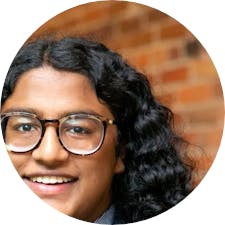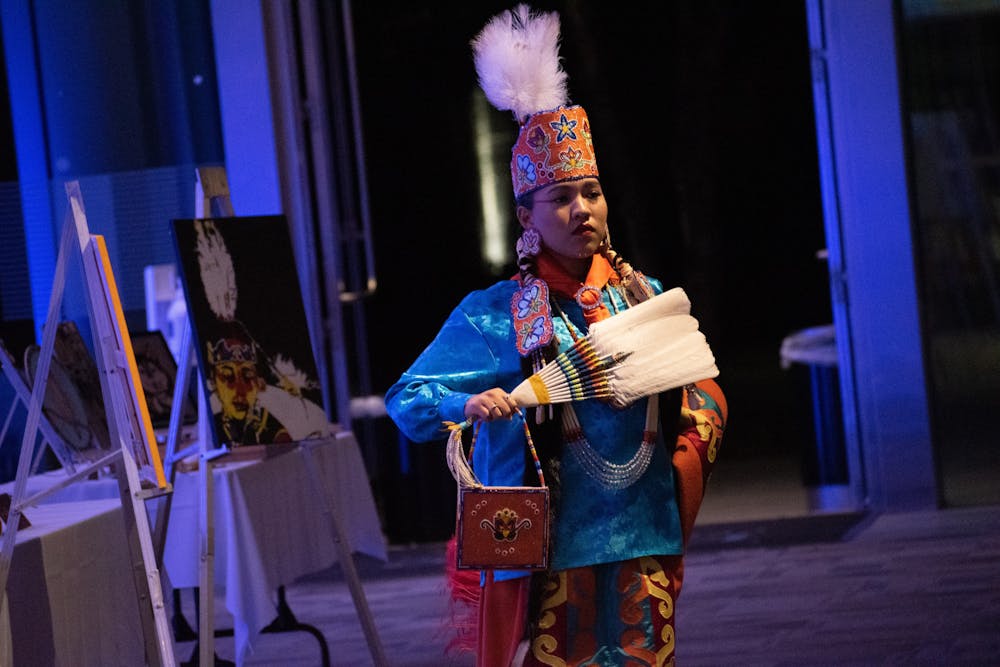The first-ever Indigenous Arts Showcase and Gala featured Indigenous artists and a student fashion show at Penn Pavilion Saturday night.
The event was hosted by the Duke Native American/Indigenous Student Alliance and the Nu chapter of the Alpha Pi Omega sorority, the only Indigenous Greek organization on Duke’s campus.
Izabella Bullard, one of the featured artists, is a citizen of the Lumbee Tribe. She stood behind her table covered with sketchbooks and paintings during the gallery walk, chatting with attendees about her work.
Bullard pointed to a larger painting featuring two women mounted on an easel next to the table. “[This painting] was inspired by a poem about Indigenous women being warriors throughout time, two generations,” she said. “I picked two Indigenous women that really inspired me.”

“On the left, we have the woman chief. She fought for her people, she was one of the most significant chiefs of her time,” Bullard said. “On the right, you have Debra Haaland who was one of the first Indigenous congresswomen, and now she is Secretary of the Interior and fights to preserve the earth and the rights of Native peoples.”
Bullard saw the showcase and gala as “a really great way to be connected with other people and the Indigenous community, and especially other artists.”
Among the art tables scattered throughout the room was an exhibition of text boards created by senior Quinn Smith, NAISA president and citizen of the Chickasaw nation. The exhibition displayed words like “blood,” “land” and “kinship,” each accompanied by the word’s significance to Smith.

One of the boards featured text written by NAISA — formerly known as the Native American Students Association — highlighting Duke’s historic mistreatment of Indigenous peoples.
The board noted that the university operated the Trinity College Industrial Indian Boarding School in the late nineteenth century. It also noted that Duke still does not have a Native Studies program, which is an ongoing demand of Native and Indigenous students of Duke.
Smith reiterated this demand at the event’s close, noting that North Carolina has the largest Native population east of the Mississippi.
“We're very grateful for the recent hire and tenure of two Native professors … and we'd like to see this continue,” Smith said, referring to a cluster hire that was completed in spring of 2021.

Get The Chronicle straight to your inbox
Sign up for our weekly newsletter. Cancel at any time.
Senior Gianni Lacey-Howard, president of the Nu chapter of APIO, NAISA co-events chair and citizen of the Occaneechi Band of the Saponi Nation, opened the programmed portion of the night.
“Although Indigenous students make up a small population on campus, it warms my heart to see and feel the solidarity in the room,” she said.
Following Lacey-Howard, Vickie Jeffries, tribal administrator for the Occaneechi Band of the Saponi Nation, gave a land acknowledgment.
“We are gathered today on land that was traditionally part of the territory of the Saponi people in the Piedmont of what is now the state of North Carolina. The Saponi people, whose descendants include the Occaneechi Band of the Saponi Nation Indian tribe, still thrive and live in this region officially recognized by the state government of North Carolina,” Jeffries said.
During the fashion show portion of the event, eight different audio stories set to instrumentals by Native artists were played over the speakers as the students who recorded them strolled past attendees.

Sophomore Reyna Cardoza, treasurer of NAISA and the Nu chapter of APIO, is Chickasaw, Cherokee, Seminole and Creek. Cardoza was part of the fashion show and spoke to the significance of what she was wearing after the event.
“I am wearing a Chickasaw collar. It is made from beads and usually from fish line. This is my mother's, actually, and she was a bridesmaid in my grandmother's traditional Chickasaw wedding. That's where she wore this, and she gave it to me to wear tonight,” Cardoza said. “I carried her with me as I walked out here, and I feel like that really strengthened me.”

The night also featured a vocal performance by A.yoni Jeffries, member of the Occaneechi Band of Saponi Nation, and Iroquois social dancing led by Patrick Suarez, citizen of the Meherrin Nation.
Lacey-Howard was proud to have been part of the gala and showcase, the first of its kind on Duke’s campus.
“It was great, being able to be a part of history and creating events that establish visibility for Indigenous students on campus,” she said after the event. “We really wanted to make a meaningful night that not only showed the resilience of Indigenous people, but also the arts and the beauty of being Indigenous.”
Cardoza reiterated the amount of energy that went into the planning process, and she believes that the energy expended won’t go to waste.
“I hope that [other Indigenous students] will see this event [and] see what we have been fighting for,” she said. “And instead of feeling alone and far from home, I want them to feel like they have family out here in support and that people are here for them.”

Vishal Jammulapati is a Trinity sophomore and an associate news editor of The Chronicle's 118th volume.

